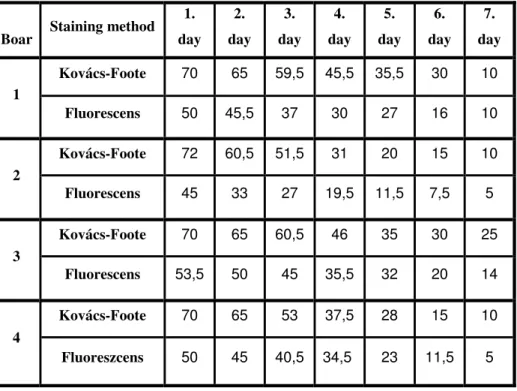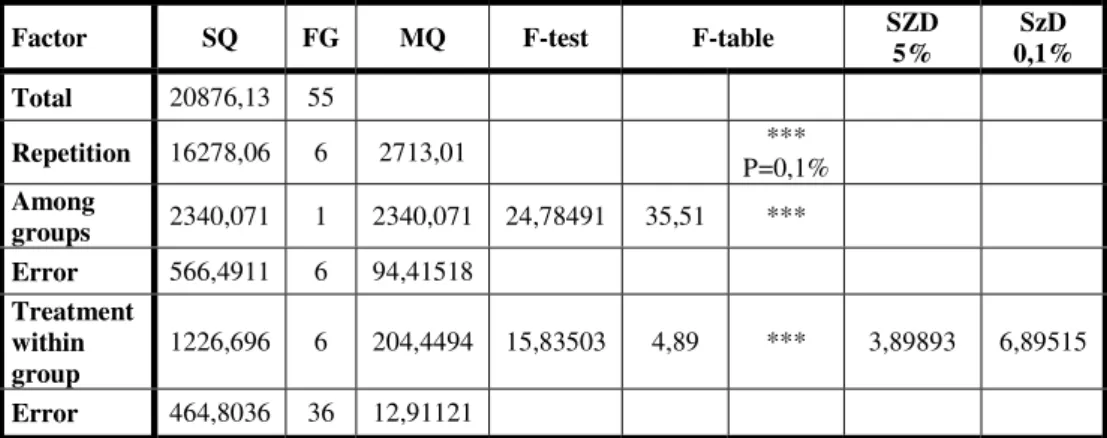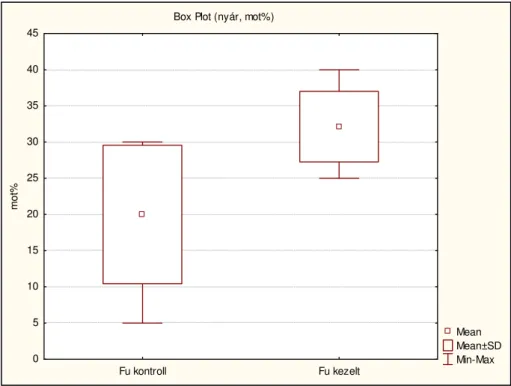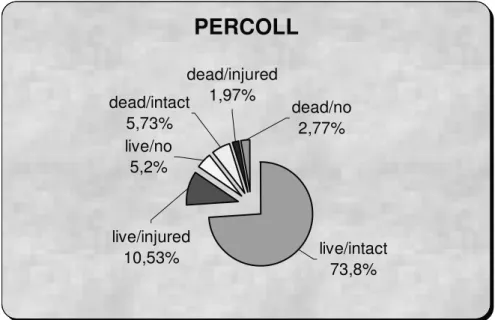THESES OF THE DOCTORAL (PHD) DISSERTATION
UNIVETSITY OF WEST HUNGARY
FACULTY OF AGRICULTURAL AND FOOD SCIENSIS INSTITUTE OF ANIMAL BREEDING
Program supervisor:
Kovácsné dr. habil. Gaál Katalin CSc
Theme supervisor:
dr. habil. Bali Papp Ágnes PhD
IN VITRO
ASSESSMENT OF FROZEN SPERM FERTILITY
Author:
MAKKOSNÉ PETZ BRIGITTA
MOSONMAGYARÓVÁR
2007
PRELIMINARIES AND OBJECTIVES OF RESEARCH WORK
Research work was already done in the past and it has also been carried out these days as for finding a solution to the long-lasting storage of semen from various domestic animals. The frozen storage proved to be the most efficient, however, the freezing-thawing procedure reduces the sperms’ motility to the half (Tuli et al 1992).
The currently used freezing procedures are imperfect. The motility of the surviving and motile sperms is different, and less active than those of the fresh ejaculations (Verheyen et al 1993). Frozen boar semen can be obtained since 1975 in the forms of both pellets and stored in straw (Johnson et al 2000).
The frozen sperms have less fertile ability than the fresh ejaculations (Almid and Hofmo 1996, Johnson 1998), thus the currently used freezing procedures should be perfect but it is far from reality. One of the reasons for this is that the boar sperms seem to be especially sensitive to the cold shock and freezing in comparison to the sperms of bulls (Polge 1956). Since it has been discovered that it is possible to increase the resistance to the cold shock by prolonging the per- freezing incubation (Pursel et al 1972), the most boar sperm deep- freezing methods include several hours’ incubation at the temperature of 15º C or below. The ideal duration of incubation in order to achieve the best quality frozen-thawed sperms is nevertheless unknown.
gaining their significance along with the traditional methods. In IVF systems, concerning the future use it is of essential importance to select the live and motile fraction of sperms from the basic substance.
There are several sperm manipulation methods elaborated for IVF of both humans and domestic animals. The best-known methods are the various washing procedures when the primary material is flushed through in certain mediums using centrifugation. One of these procedures is the centrifugation or washing of Percoll gradients (Devries and Colenbrander 1990, Mermillod et al (1992)). In IVF systems, the various sperm migration procedures are of remarkable function as well. The most wide-spread of these migration procedures is the swim-up (Drevius 1972, Lopata et al 1976). During the swim- up, a sperm amount of one unit (usually one or two units of artificial straw) is placed under the medium of specified capacity which is incubated making the motile sperms are able to swim up into the upper layer. Parish et al (1986) were the first to introduce the swim-up for domestic animals.
Objectives:
The aim of our first series of experiments was to estimate daily the number of live/dead sperms stores at 17º C in vitro circumstances during a seven-day-long experiment; and to trace the changes in the motility of sperms and the acrosome modifications applying the two staining methods parallelly. Having compared them to the samples of subjective motility examinations, the further method for assessing sperm viability was going to be selected.
In the second series, we decided upon each step of the pre-freezing treatments used for long-term storage and the effects of these on the frozen-thawed boar semen. Getting the information on these facts, we examined the effect of the prolongation of pre-freezing incubation time in the viability of boar semen, membrane integrity and also on motility.
Our aim was to shed light on the occasional seasonal discrepancies therefore we carried out our experiments both in summer and in winter.
In the third phase, we applied different treatments on behalf of improving the efficiency of fertilization. To obtain all these results, we examined the effects of the short-time centrifugation, the swim-up and the Percoll-type treatment on the frozen-thawed boar semen.
MATERIALS AND METHODS
1. THE SITES OF EXAMINATIONS
Our examinations were carried out at the University of West Hungary, at the Faculty of Agriculture and Food Sciences and also at the Artificial Insemination Station of Debrecen.
2. METHODS FOR SPERM EXAMINATION
2.1. Motility Examination
The motility examination was carried out by an independent expert with the help of a Zeiss-type light microscope on heated (38ºC) objective table.
2.2. Staining Procedures
Kovács-Foote’s (1992) and Harrison-Vicker’s (1990) fluorescent staining procedures were applied.
3. STATISTICAL ANALYSIS
The results gained by short-term sperm storage and examined with both kinds of staining procedures were analyzed with the ANOVA/NANOVA part of Statistica program.
The examination data of the effect of the longer incubation time were arranged with Microsoft Excel program, and were evaluated with Statistica for Windows 6.0 statistical softver. (The information underwent variance-analysis examination in order to figure out the effect of the sperm treatment.) Finally, the significant discrepancy between the treatment and control was verified by t-test.
The single-factor variance analysis of the results got by the examinations of the pre-fertilisation sperm treatment methods was done using the above mentioned ANOVA/NANOVA part of Statistica program that was supplemented with Tukey-test when it was required.
RESULTS
1. Selection of the method for assessing sperm viability and the effect of short-term storage on the semen
We wanted to know how the quality of the sperm changed during the short-term storage and whether there were emerging any discrepancies in the results applying the 2 kinds of staining methods.
Table 1. The proportional changes in the unstained tail live sperms with normal acrosome during the short-term storage examined with 2 kinds of sperm-estimating methods (%).
Boar Staining method 1.
day 2.
day 3.
day 4.
day 5.
day 6.
day 7.
day
Kovács-Foote 70 65 59,5 45,5 35,5 30 10
1
Fluorescens 50 45,5 37 30 27 16 10
Kovács-Foote 72 60,5 51,5 31 20 15 10
2
Fluorescens 45 33 27 19,5 11,5 7,5 5
Kovács-Foote 70 65 60,5 46 35 30 25
3
Fluorescens 53,5 50 45 35,5 32 20 14
Kovács-Foote 70 65 53 37,5 28 15 10
4
Fluoreszcens 50 45 40,5 34,5 23 11,5 5
At the preliminary examination of the four male boars’ semen, it was seen that the proportion of moving sperms in the ejaculatum was approximately seventy per cent. Applying Kovács-Foote’s procedure, the semen appeared a bit of higher quality than at the fluorescent staining. This tendency remained throughout the seven days. During the examination, both procedures showed that the quality of the semen was worsening day by day.
During the storage, the number of live sperms with normal acrosome, showing unstained tail was decreasing continually whichever method was used tracing it. The F-test was conducted to see whether the displayed tendency of quality decreas was changing in the same extent. At the statistical evaluation, four males’ average results were taken into consideration and were also compared with two methods.
Table 2. Double-sampled F-test on variance
Factor SQ FG MQ F-test F-table SZD 5%
SzD 0,1%
Total 20876,13 55
Repetition 16278,06 6 2713,01 ***
P=0,1%
Among
groups 2340,071 1 2340,071 24,78491 35,51 ***
Error 566,4911 6 94,41518 Treatment
within group
1226,696 6 204,4494 15,83503 4,89 *** 3,89893 6,89515 Error 464,8036 36 12,91121
From the above table, it is seen that the value of F is lower than the critical F value, so there is no discrepancy between the quality changes in the variances of tendency lines displayed with two methods.
The above results demonstrate that quality deterioration apparent during short-term storage can be similarly detected applying either staining procedure. At the further experiments, Kovács-Foote’s staining was done.
2. The effect of the prolongation of the pre-freezing incubation time on the sperms’ membrane integrity
In this series of experiments, it was searched what effect the prolongation of the pre-freezing incubation time can have on the quality of the semen. To reveal the occasional seasonal discrepancies, the whole series of examination was carried out twice, once in summer and them in autumn.
Applying Kovács-Foote’s staining; there is a significant difference between the group containing stained sperm tails and the traditionally cooled and treated group. The below diagram clearly demonstrates this inequality.
Fig. 1. Box-whisker diagram. The average, average±scattering;
minimum and maximum figures of the staining data (live, normal and motile sperms) of the control and treated groups (summer)
There is also a significant difference presented at the motility examination of the control and the treated groups. The difference is shown by the below diagram.
Box Plot (nyár, f estés%)
Mean Mean±SD Min-Max
Fu kontroll Fu kezelt
10 20 30 40 50 60 70
festés %
Fig. 2. Box-whisker diagram. The average, average±scattering;
minimum and maximum figures of the motility examination of the control and treated groups (summer)
Comparing the results revealing the viability together with motility within both the treated and the control groups with the results of the motility examinations, it was evident that the difference were significant.
The results of the experiments performed in summer and in autumn were averaged and the t-test was done. At the statistical evaluation of both the staining results and of the motility examinations, a significant
Box Plot (nyár, mot%)
Mean Mean±SD Min-Max
Fu kontroll Fu kezelt
0 5 10 15 20 25 30 35 40 45
mot%
the results of each individual, no outstanding divergence was experienced. The experiments performed in summer and in autumn revealed no significant discrepancy either.
3. Treatment of sperms after freezing and thawing (short-term centrifugation, swim-up and Percoll-treatment)
This time, out of the several post-freezing-thawing sperm treatment procedures it was examined what effects the short-term centrifugation (10 minutes at 200g), the swim-up (through Sperm TALP medium) and the Percoll gradient treatment had on boar sperms. These experiments manifested the differences in the efficiency of the 3 treatments.
BEFORE TREATMENTS
dead/injured 17,20%
dead/no 12,77%
dead/intact 12,17%
live/intact 35,53%
live/injured 10,63%
live/no 11,7%
CENTRIFUGATION
live/intact 57,13%
live/injured 6,53%
live/no 3,97%
dead/intact 9,4%
dead/injured 17,33%
dead/no 5,63%
Fig. 4. The configuration of the different sperm-categories after centrifugation
SWIM-UP
dead/no 3,80%
dead/injured 9,4%
dead/intact 8,23%
live/no 11,23%
live/injured 16,33%
live/intact 51%
Fig. 5. The configuration of the differ4ent sperm-categories after the swim-up
PERCOLL
dead/no 2,77%
dead/injured 1,97%
dead/intact 5,73%
live/no 5,2%
live/injured
10,53% live/intact
73,8%
Fig. 6. The configuration of the different sperm-categories after Percoll-treatment
Subsequent to all 3 treatments, the proportion of the live sperms with normal acrosome is higher than those of the control group. With boar sperms, the best result was induced by the Percoll-treatment, which was ensued by the results of centrifugation; and the swim-up was the least successful. All these 3 treatments significantly (P<0.005) influenced the proportion of spermatozoa with live, intact acrosome in the semen.
NEW SCIENTIFIC RESULTS
1. The longer incubation affected positively the sperms’ viability; the proportion of the motile and live sperms with normal acrosome was significantly higher subsequent to the longer incubation than in the case of the control ones.
2. In our experiments, the longer incubation caused discrepancies in the motility of sperms as well which proved to be significant according to the variance analysis.
3. Any of the sperm treatment methods – swim-up, centrifugation, Percoll-gradients – applied for increasing the efficiency of in vitro fertilization resulted in a notably bigger amount of live sperms with normal acrosome than in the untreated control group.
4. Out of the various treatments, the Percoll gradients treatment appeared to be the most effective.
PROPOSALS
To trace the qualitative changes during the short-term storage of sperms, there were two kinds of in vitro staining methods applied. In our examinations, we employed the Kovács-Foote’s (1992) staining and also the modified Harrison and Vickers fluorescent staining (1990).
During the seven-day storage experiment performed at 17º C in vitro circumstances, we evaluated daily the number of live/dead sperms;
registered the acrosome changes; and also concluded the cell motility from the permeability of the tail-membranes of the live sperms with normal acrosome. The results of vital staining were compared to the ones of the motility examinations. Both methods are suitable to trace the qualitative alterations during the sort-term storage. In practice, however, the method described by Kovács and Foote seems to be more favourable because its implementation is simple, does not require special laboratory conditions; and it provides a detailed picture not only of vitality of cells but also of the acrosome and the tail membrane integrity.
In our experiments, the prolongation of the incubation time had a positive effect on the viability of the sperms - the proportion of motile and live sperms with normal acrosome was significantly higher subsequent to longer incubation than in the case of control ones. In
Numerous researchers have already applied the processes of centrifugation, Percoll-type and swim-up treatments examining the frozen-thawed fertilizing materials.
As a result of our work, all the 3 various treatments verified that both the short-term centrifugation and the swim-up and the Percoll- treatment concentrate efficiently the live sperms with normal acrosome. Out of these different treatments, the Percoll gradients treatment proved to be the most efficient. This sperm per-treatment is worth being employed in the future so that in vitro fertilization can become more perfect and wide-spread.
References:
Almid T., Hofmo P.O.: Reprod. Dom. Anim, 1996, 5, 117-125.
Devries A.C., Colenbrander B.: Int. J. Biochem. 1990, 22, 519-524.
Drevius L.O.: J. Reprod. Fertil. 1972, 24, 427-432.
Harrison R.A.P, Vickers S.E: J. Reprod. Fert. 1990, 88, 343-352.
Johnson L.A.: Proc. 15th Int. Pig Vet. Soc. Congress Vol 1, 1998, 225-229.
Johnson L.A., Weitze K.F., Fiser P., Maxwell W.M.C.: Anim. Reprod.
Sci., 2000, 62, 143-172.
Kovács A., Foote R.H.: Biot. Histoc. 1992, 67, 119-124.
Lopata A., Patullo M.J., Chang A., James B.: Fertil. Steril. 1976, 27, 677-684.
Mermillod P., Massip A., Dessy F.: Int. J. Dev. Biol. 1992, 36, 185- 195.
Parrish J.J., Susco-Parrish J.L., Leibfried-Rutledge M.L., Critser E.S., Eyestone W.H., First N.L.: Therio. 1986, 25, 591-600.
Polge C.:Vet. Rec. 1956, 68, 62-76.
Pursel V.G., Johnson L.A., Schulman L.L.: J. Anim. Sci. 1972, 35, 580-584.
Tuli R.K., Schmidt-Baulain R., Holtz W.: Therio. 1992, 38, 487-490.
Verheyen G., Pletincx I., VanSteirteghem A.: Hum. Reprod. 1993, 8,
SCIENTIFIC PUBLICATIONS AND LECTURES FROM THE TOPICS OF THE THESIS
Scientific reports published in edited papers
1. B. Petz Makkosné – E. Deak – Á. Bali Papp - J. Iváncsics (2003): Examination of different boar’ semen during short storage. Állattenyésztés és Takarmányozás 51 131-136
2. E. Varga – B. Petz Makkosné – E. Gajdócsi – I. Salamon – Á Bali Papp (2007): Vitrification of in vitro matured oocytes of Mangalica (Hungarian native breed pig) and Large White pig. Acta Veterinaria Hungarica (accepted) (IF: 0535)
3. Makkosné Petz B. – Salamon I. – Koltai J. – Pécsi T. – Bali Papp Á. (2007): The Effects of the longer equilibrations Time on the Membrane Integrity of Boar Semen, Acta Agraria Kaposvariensis (accepted)
4. Makkosné Petz B. – Kiss R. – Bali Papp Á (2007): The history of the storage of boar semen. Acta Agraria Kaposvariensis (accepted)
Lectures and abstracts:
1. B. Petz – Á. Bali Papp – T. Somfai – L. Nánássy – T. Pécsi – J. Iváncsics (2002): Effect of percoll or short time centrifugation treatment on viability and acrosome integrity of frozen/thawed boar spermatozoa. Theriogenology (Abst.) 57 681. (IF: 2,387)
Informatory publications:
1. Makkosné Petz B. - Bali Papp Á. – Kovácsné Gaál K.
(2003): Sperm Deep-Freezing as One Possible Method for Preserving Biological Diversity. 5th Hungarian Congress on Genetics in Siófok; 13th-15th April (Lecture)
2. Bali Papp Á. - Makkosné Petz B. ––Nánássy L. –Pécsi T. – Dohy J. - Iváncsics J. (2002): Effect of different treatment on freezing/thawed boars’ sperm.. XXIX. Scientific Days in Óvár.
Mosonmagyaróvár, 2002. október 3-4. Summary of lectures and posters 29 (Poster)
3. Makkosné Petz B. - Bali Papp Á. - ––Nánássy L. –Pécsi T. – - Iváncsics J. (2002): Freezing ability of boars’ semen depending on the season. XXIX. Scientic Days in Óvár:
Mosonmagyaróvár, 2002 október 3-4. Summary of lectures and posters 60.(Poster)
4. A. Bali Papp - T. Somfai - B. Petz - L. Nánássy T. Pécsi– J.
Iváncsics (2001): How can influence the different treatment of frozen/thawed boar spermatozoa viability. BOKU International Congress, 18-21. November, Wien, Austria 181. (Poster) 5. Á Bali Papp - T. Somfai – Zs. Angyal – B. Petz – T. Pécsi –
Sz. Bodó – J. Iváncsics (2001): Effect of percoll and swim up treatment on viability and acrosome integrity of frozen/thawed boar spermatozoa Second International Workshop on Mammary Gland Biotechnology 30-31 August, Budapest, Hungary 34. (Poster)
6. Makkosné Petz B. – Baráth Zs. – Nagy Sz. – Bali Papp Á. – Iváncsics J. (2000): Examination of different boar’ semen





